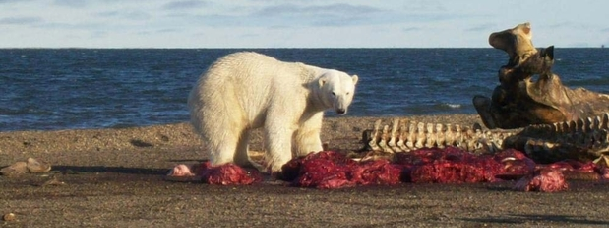Starving polar bears encroach on Alaska town as Arctic ice recedes
STRANDED: With nowhere to go they stay on land, creating hazard. 
By KYLE HOPKINS
khopkins@adn.com
Published: May 3rd, 2010 02:23 PM
Last Modified: May 3rd, 2010 03:14 PM For $16 an hour, Morgan VanHatten patrolled the streets of Kaktovik in a Ford pickup last fall armed with a 12-gauge shotgun and an iPhone full of Lil Wayne. Her mission: Shoo away the many polar bears that creep into town at the brink of whaling season. “They come in and they usually just hang out at the whale bones and stuff,” said VanHatten, a 25-year-old who would sometimes break up her shift to take college courses in business and human resources over the phone. “Some people that don’t put their whale meat away in their yard, that’s when they come into town because they smell it, and it would make my job kind of frustrating.” Researchers say that as Arctic sea ice recedes, the chance for human and polar-bear encounters is increasing along the North Slope. Now, following the 2008 listing of the bears as threatened under the Endangered Species Act, the U.S. Fish and Wildlife Service is proposing a list of guidelines for warding the animals away from towns and villages. … Now that once-permanent sea ice along the coast is being replaced by unpredictable young ice, more polar bears appear to find themselves stuck on land, he said. “Over the past couple years, we’ve probably had anywhere from four or five to almost 20 locked on the land and the ice is just too far out that they don’t swim,” Snowball said. … In Kaktovik, VanHatten circled the village between 4 p.m. and midnight last fall, Jay-Z’s “Run This Town” spilling out onto the tundra. Sometimes she stopped to pick up neighbors walking in the Arctic cold. The bears were hungrier and more bold than when she first joined the polar bear patrol in 2007. “They were like, starving. I couldn’t believe the difference,” VanHatten said. One night after class she found a mother and two cubs eating outside a home in the heart of town. The bears split, but soon returned to the village and were later killed because the mother was hurt, VanHatten said. The kills were considered a subsistence take, according to the Wildlife Service. “This year I needed a lot of help from other vehicles, because I swear those bears would know when I would take off to one end of the village,” VanHatten said. “They’d start coming in, and there’s other bears coming in from the other side. “I just couldn’t believe how many there were.”
Polar bear patrols vital as Arctic ice recedes